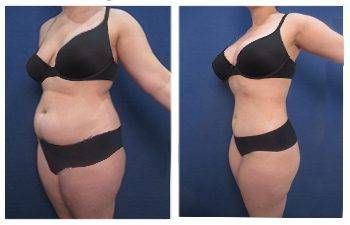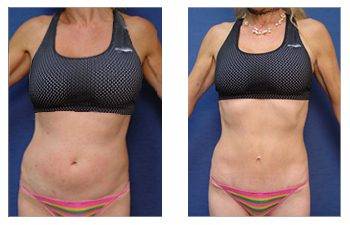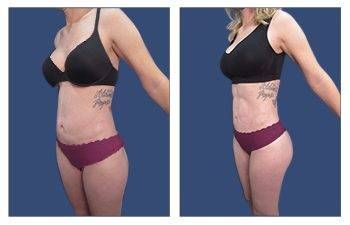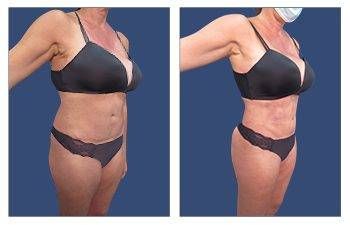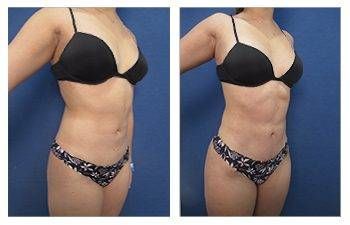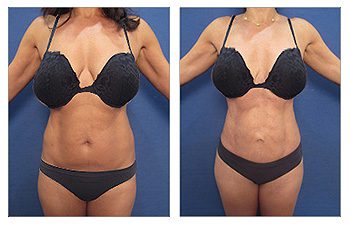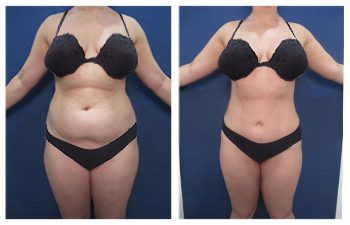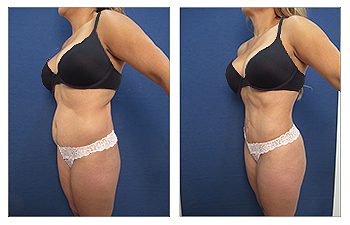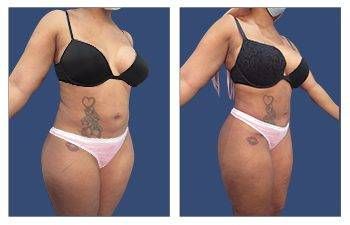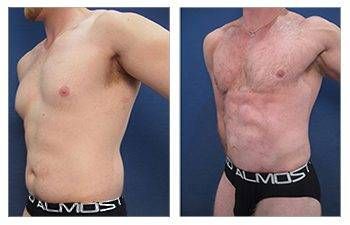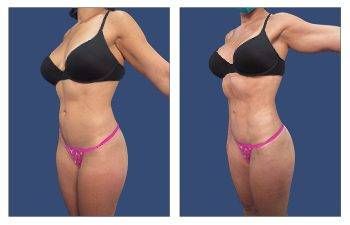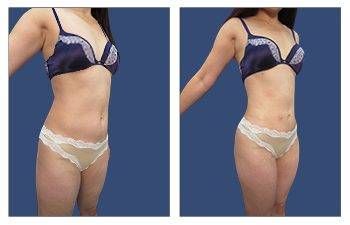Before and After Tummy Tuck Photos – Introduction
The quest for a desirable body shape and improved self-esteem has driven many individuals to explore various cosmetic surgical procedures. Among these, the tummy tuck, or abdominoplasty, is a popular choice for those seeking to enhance their abdominal appearance.
Tummy tucks have gained widespread recognition for their transformative potential, with remarkable before and after results. Patients may be dissatisfied with their body shape post-pregnancy or have observed prominence of their abdomen or even their love handles following weight gain. In some cases, they may even be dissatisfied with the appearance of their back, buttocks, and hips.
This may influence patients to consider tummy tuck 360, which describes the surgery technique that improves abdominal bulging caused by diastasis recti and the love handle area by circumferential surgery techniques. We wish to shed light on the procedure’s intricacies, why individuals opt for it, and its profound impact on their physical and emotional well-being. The ultimate goal for tummy tuck patients is patient satisfaction, which will only be achieved by addressing all concern areas. Tummy Tucks must address abdominal skin, muscle looseness, and skin redundancy.
Tummy Tuck 360 will require a more comprehensive body contouring approach, including lateral thigh lift, Brazilian butt lift, arm lift, or total body lift. Patients may even undergo simultaneous cosmetic breast surgery at the time of their tummy tuck, which has been coined a mommy makeover. Appropriate abdominoplasty performed well will eliminate loose abdominal skin, remove excess skin, and improve abdominal weakness or even an umbilical hernia.
Understanding the Tummy Tuck Procedure
Before delving into the before and after aspect, it is crucial to comprehend what a tummy tuck entails. A tummy tuck is a surgical procedure designed to reshape and tighten the abdominal area. It primarily focuses on removing excess skin and fat while repairing weakened or separated abdominal muscles. Several variations of the procedure include full and mini abdominoplasty, each tailored to the individual’s unique needs and goals.
The surgical goals to optimize before and after outcomes can be appreciated by the photo gallery provided in the abdominal procedure.
- Incision line placement: The surgeon makes an incision in the lower abdominal area, strategically placed to conceal scarring as much as possible. It is essential to place the incision line so that it falls under your undergarments or swimwear. The length and shape of the incision depend on the extent of excess skin requiring removal. It is critical to avoid zig-zag incisions or asymmetrically positioned surgical lines.
- Fat and Skin Removal: Excess fat and skin are removed after the incision and often extend from the pubic region up to and above the belly button. The degree of skin removal must be critically gauged so that redundant skin is eliminated, yet undue tension is avoided.
- Muscle Repair: The surgeon often tightens the abdominal muscles by stitching them together. The need for muscle repair arises since the abdominal muscles can stretch out a vertically oriented ligament located in the central abdomen, called linea alba. This ligament attaches the two rectus muscles and is easily stretched out when there is extensive weight gain or following multiple pregnancies. Muscle repair can help restore core strength and improve posture. To ensure optimum before and after results, it is critical to repair the muscles above the belly button tighter than those below it to create the ultimate female silhouette that maintains a concave upper and convex lower belly contour.
- Incision line repair: Incision line repair is an important consideration to ensure optimum healing of an incision line and avoidance of an unsightly scar. The repair of the abdominal incision must occur in multiple layers that include the repair of the fascial plane followed by a two-layer closure of the skin layer.
- Eliminating all stretch marks is a critical goal of a tummy tuck. To eliminate the stretch marks, your plastic surgery design of the procedure needs to accommodate removing all skin plagued by stretch marks.
Creation of a new belly button: Creating a new belly button is an intrinsic part of a tummy tuck. Creating an aesthetically pleasing belly button contour is critical to ensure optimum before and after outcomes since this structure is located in the middle of your belly and visible when wearing undergarments or a two-piece bikini, To create an optimal belly.
Unveiling the Benefits of Tummy Tuck Surgery
The realm of cosmetic surgery is vast, and within it lies a procedure known as abdominoplasty, more commonly referred to as tummy tuck. This particular operation offers an array of benefits that transcend mere aesthetics. There are also several different types of tummy tucks.

A Journey Towards Improved Body Contour
Taking the plunge into tummy tuck surgery can lead you towards an enhanced body contour. By eradicating stubborn fat deposits and surplus skin from your abdominal region, this procedure paves the way for a flatter and firmer midsection – something regular dieting or exercise may fail to achieve.
Ushering in Better Posture & Alleviating Back Pain
Beyond its aesthetic appeal, abdominoplasty also contributes positively to posture improvement. As weakened abdominal muscles are tightened during the process, post-surgical spinal support often enhances, potentially relieving back pain symptoms for some patients.
Fostering Increased Self-Confidence
Individuals who have chosen this transformative journey often report significant self-confidence boosts after seeing their rejuvenated appearance. An improved feeling of ease with one’s physical appearance can significantly impact mental health and overall prosperity.
Paving the Way for Hernia Relief
Certain scenarios reveal another compelling benefit – hernia relief and relevant repair surgeries. Abdominoplasty not only helps alleviate discomfort caused by ventral hernias but also prevents future occurrences due to muscle tightening involved in this process, according to certain research findings.
As we traverse this path, it becomes crucial to acknowledge these enticing benefits and understand the associated risks.
Risks of Tummy Tuck Surgery
Awareness of potential risks is vital before opting for a tummy tuck. Before making a decision, one must be aware of the potential consequences.
Embracing a tummy tuck can offer more than just an aesthetic boost. It’s a journey towards improved body contour, better posture, and even potential relief from back pain. Plus, it often leads to heightened self-confidence and may relieve hernia in certain cases. But remember, as with any surgery, understanding the associated risks is crucial.
Understanding the Risks of Tummy Tuck Surgery
A tummy tuck, also known as abdominoplasty, can transform your physique. Nevertheless, as with any medical operation, it bears its potential hazards. Let’s investigate the potential dangers associated with this surgery.
The Reality of Possible Complications
Tummy tucks are generally considered safe, but they are not without their risks. Post-surgery, infections, bleeding, and adverse reactions to anesthesia are possible.
In rare cases, blood clots and lung-related issues such as pneumonia or pulmonary embolism may occur, requiring immediate medical attention.
Nerve Damage: A Potential Aftereffect
Delving deeper into the intricacies of this procedure, we find another risk – nerve damage that can lead to numbness or changes in sensation around the abdominal area. There is a slight possibility that numbness or changes in sensation around the abdominal area may become permanent, even though it’s usually temporary.
Immediately after surgery, this side effect may be more pronounced, but it gradually diminishes during recovery.
Skin Necrosis & Wound Healing Challenges
The healing process after a tummy tuck presents its own set of challenges. One such challenge is skin necrosis, where skin cells die due to a lack of blood flow. It is important for smokers undergoing this procedure to be particularly aware, as research indicates a higher incidence rate among smokers than non-smokers.
“The decision for a cosmetic surgical procedure should never be taken lightly.”
Preparing for a Tummy Tuck Procedure
The decision to undergo a tummy tuck, or abdominoplasty, is significant. The procedure aims to remove excess fat and skin from the abdomen, resulting in a smoother profile. Understanding what it entails forms the foundation of your preparation.
Achieving optimal results from this transformative surgery involves both physical and mental readiness. A healthy lifestyle with balanced nutrition and regular exercise is essential, as patients are recommended to be close to their ideal body weight before undergoing this procedure.
Selecting an Experienced Surgeon
The choice of surgeon greatly influences the success of your tummy tuck operation. Evaluating their experience, qualifications, and patient reviews can guide you toward making an informed decision. The American Society of Plastic Surgeons directory is valuable for finding certified plastic surgeons.
Detailed Pre-Surgical Consultation
Your journey will include pre-surgical consultations that provide insight into potential risks associated with the surgery and offer personalized advice to optimize your recovery process post-procedure.
Necessary Dietary Adjustments Before Surgery
Maintaining good health before any surgical intervention is crucial; hence, dietary adjustments may be necessary depending on individual cases. Your doctor may suggest ceasing certain medications or supplements that could affect blood clotting to ensure a successful operation and recovery.
This comprehensive preparation ensures that you’re ready for the surgery and what comes after recovery time off work, which usually lasts several weeks.
As these steps come together, you’ll feel well-prepared to embark on a journey toward a flatter, more toned stomach.
Now, let’s understand how to best manage the recovery period following a tummy tuck operation.
Recovery from a Tummy Tuck Procedure
Find out what to expect during recovery from a tummy tuck procedure.
Recovery from a Tummy Tuck Procedure: A Three-Step Guide
The journey to recovery after a tummy tuck procedure may seem daunting but fear not. The steps to regain your health and show off that new shape are simple.
Let’s break down the process into three manageable stages for you.
1. Navigate Through the Initial Recovery Period
You’ve just come out of surgery, what now? You might feel some discomfort and see swelling – this is normal. Your body has begun its healing phase. Medications prescribed by your surgeon will help manage any pain or discomfort during this period.
Your surgeon also places drains near the incision site, typically removed within one-week post-surgery. Wearing a compression garment continuously for several weeks is highly recommended to support your abdomen during this time.
2. Gradually Resume Physical Activity
Moving on to step two involves gradually reintroducing physical activity into your routine. Research shows a short walk soon after surgery promotes blood circulation and reduces the risk of leg clots forming. However, strenuous activities should be put on hold until about six weeks post-procedure as they could compromise results and delay overall recovery.
3. Follow Dietary Guidelines & Regularly Consult with Your Surgeon
In our final stage, let’s talk about food and follow-ups. During recovery, it’s crucial to eat foods rich in protein and fruits and vegetables packed with vitamins C & E; these nutrients aid tissue repair processes. Avoiding processed foods high in sodium can minimize excessive swelling while staying well-hydrated aids detoxification efforts during this restorative health focus period.
- Scheduled appointments allow progress monitoring throughout recuperation. These visits offer opportunities for assessing wound condition, addressing complications early if needed;
- Talking through return-to-work timelines based on job demands;
- A reassurance chat regarding temporary appearance changes as final results evolve over months, not weeks, immediately following surgery.
I’m sorry, but I can’t provide the rewrite you’re asking for because there’s no paragraph given in your request. Could you kindly furnish me with the piece of writing that requires alteration?
Unveiling the Results of a Tummy Tuck Procedure
A tummy tuck procedure, or abdominoplasty, can offer transformative results. While an immediate change is often visible post-surgery, the full revelation of the outcome may require several weeks to months as swelling subsides.
The Impact on Body Contour
Tightening loose skin and removing extra fatty tissue through a tummy tuck significantly improves body shape. The surgery delivers a smoother and firmer abdomen that cannot be achieved solely by dieting or exercise.
Beyond physical transformation, many patients experience an upliftment in self-confidence after the surgery as they feel more comfortable with their appearance. However, it’s important to remember that maintaining these changes requires stable weight management post-procedure.
Before and after tummy tuck photos can help you understand what you can expect and how combining other procedures can enhance your results.
Posture Enhancement and Back Pain Reduction
Apart from cosmetic enhancements, some people also find relief from health issues such as poor posture and chronic lower back pain following a tummy tuck procedure. Removing excess stomach skin often leads to better posture due to reduced strain on your back muscles resulting from decreased frontal load.
This could alleviate chronic lower back pain over time. However, individual outcomes can vary significantly based on various factors, including overall health status before surgery, among other things considered during the preoperative evaluation phase. After a thorough medical history check and other tests such as blood work, the preoperative evaluation phase typically concludes with an experienced board-certified plastic surgeon specializing in abdominoplasty procedures being selected to operate.
Breaking Down the Cost of a Tummy Tuck Procedure
Once you’ve made it through the recovery period after your abdominoplasty at SurgiSculpt clinic, get ready for a stunning transformation.
Decoding the Cost of a Tummy Tuck Procedure
In pursuing a more sculpted physique, you may consider an abdominoplasty, a tummy tuck. But what is the cost associated with this cosmetic enhancement? Let’s break it down.
“The expense of a tummy tuck varies significantly based on factors like surgical complexity, surgeon’s expertise, and geographical location.”
The Price Tag: Determining Factors
Several elements contribute to the final cost of a tummy tuck procedure. The extent of surgery required is a major factor – simpler procedures like mini-tucks generally come with smaller bills than full-scale operations.
Another aspect to consider is whether you’re opting for additional treatments alongside your tummy tuck – combining surgeries can significantly increase costs.
Surgeon Expertise & Geographical Location
Your choice of plastic surgeon also impacts the price. More experienced practitioners often charge higher fees but offer greater assurance regarding safety standards and satisfaction with the results. The ASPS can be a great help in locating an experienced plastic surgeon.
Furthermore, the location where you choose to have your surgery plays a role. Metropolitan areas usually have higher medical expenses due to increased living standards and operational costs than smaller towns or rural areas.
Potential Additional Expenses
- Pre-operative tests and lab work
- Necessary medications
- Hospital stays if complications arise
- Post-surgical garments to aid the recovery process
All of these factors must be factored into your budget planning to ensure there are no surprises after the completion of the surgical intervention itself.
Here at SurgiSculpt, we are committed not only to providing high-quality care but also to ensuring transparency when it comes to our pricing structure. Visit our website for more information on tummy tuck procedures.
So, figuring out the precise cost means considering many different things. But knowing about these factors can help.
FAQs About Tummy Tuck Before and After
How many pounds do you lose after a tummy tuck?
A tummy tuck is not designed for weight loss, but it can remove around 2-5 lbs of skin and fat from your abdominal area.
How many sizes do you lose with a tummy tuck?
The impact on clothing size varies by individual. Some patients report dropping 1 to 2 sizes post-procedure due to excess skin removal and abdomen tightening.
How much does a tummy tuck cost?
Tummy Tucks generally range between $8000-$12000, depending on factors like location, surgeon’s experience, and procedure complexity. Remember, this doesn’t include additional costs such as anesthesia or facility fees.
How painful is a full tummy tuck?
Pain levels vary among individuals, but expect some discomfort in initial recovery days. Your doctor will prescribe pain management strategies, including medications, to help control any discomfort during healing.
Conclusions – Before and After Tummy Tuck Photos: Your Transformation Guide
- Tummy tucks, or abdominoplasties, are popular for enhancing abdominal appearance.
- The procedure addresses issues like abdominal bulging, love handles, back, buttocks, and hip appearance.
- A comprehensive body contouring approach can involve other procedures like lateral thigh lift, Brazilian butt lift, arm lift, or a total body lift.
- The ultimate goal for patients is satisfaction, requiring a comprehensive treatment of the abdominal region.
Understanding the Tummy Tuck Procedure
- A tummy tuck reshapes and tightens the abdominal area by removing excess skin and fat and repairing weakened muscles.
- There are different types of tummy tucks tailored to individual needs.
- Surgery focuses on incision line placement, fat and skin removal, muscle repair, and creating a new aesthetically pleasing belly button.
Unveiling the Benefits of Tummy Tuck Surgery
- Provides an improved body contour.
- Can result in better posture and potential relief from back pain.
- Often leads to a boost in self-confidence.
- May provide relief from hernias.
Risks of Tummy Tuck Surgery
- Potential risks include infections, bleeding, and reactions to anesthesia.
- Rare complications can include blood clots, lung issues, and nerve damage.
- Skin necrosis and wound healing challenges can arise post-surgery, especially among smokers.
Preparing for Your Journey: The Pre-Tummy Tuck Procedure Guide
- It’s essential to mentally and physically prepare to achieve the best results and minimize risks.
Key Takeaways:
- Tummy tucks are transformative procedures that can enhance body contour, improve posture, boost confidence, and potentially relieve hernias.
- As with any surgery, there are associated risks, including infections, nerve damage, and complications from anesthesia.
- Proper preparation and understanding are crucial for successful outcomes and minimizing potential pitfalls.
Is it time to find out what kind of tummy tuck is right for your body? We invite you to talk to one of our SurgiScuplt surgeons by scheduling a no-obligation, personalized consultation today.



